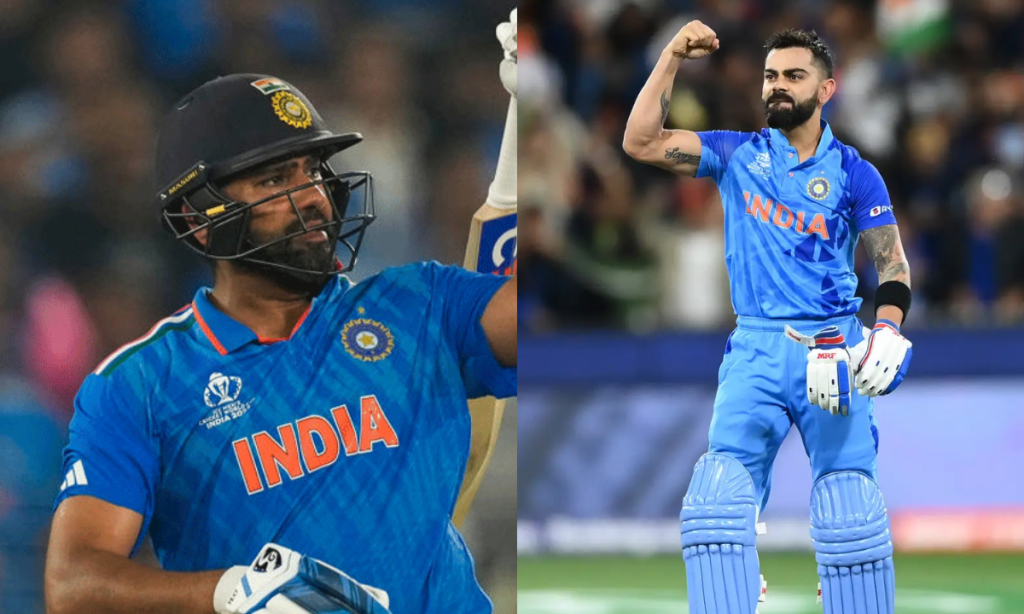When it comes to Indian cricket, two names often dominate the conversation: Virat Kohli and Rohit Sharma.
Both have been pivotal in India’s cricketing successes in recent years, especially in ICC tournaments, where the pressure is at its peak and the stakes are highest.
Let’s dissect their performances in these crucial games to see who emerges as the statistical leader in ICC events.
White-Ball Cricket: The Battle of Averages
Rohit Sharma’s journey in ICC tournaments began with the 2007 T20 World Cup, where he made an immediate impact.
Over the years, across 85 matches in two white-ball formats, he has accumulated 3276 runs at an impressive average of 46.80.
Rohit’s ability to score big in crucial matches, especially his three double centuries in ODIs, showcases his dominance in white-ball cricket.
His consistency and ability to change the game’s tempo with his aggressive style have made him a cornerstone of India’s batting lineup in these tournaments.
On the other hand, Virat Kohli, who debuted in an ICC event in 2009, has played an equal number of matches – 85 – in white-ball formats for ICC tournaments. Kohli has scored 3616 runs, surpassing Rohit in sheer volume of runs.
However, it’s his staggering average of 62.34 that sets him apart. Kohli’s record is not just about big scores but also about consistency, with numerous half-centuries and centuries in high-pressure scenarios.
His performance in the 2014 T20 World Cup and the 2011 World Cup are testaments to his big-match temperament.
In white-ball ICC tournaments, Kohli’s higher average clearly gives him an edge over Sharma.
However, Rohit’s ability to score double centuries, a feat Kohli hasn’t achieved in ODIs, showcases a different aspect of greatness – the capacity for monumental innings that can single-handedly define matches or even tournaments.
The Test of Time: World Test Championship
Moving to Test cricket, where form and conditions can vastly differ from game to game, the World Test Championship (WTC) provides another platform to compare these two stalwarts.
Rohit Sharma, often criticized for his Test performances early on, has shown significant growth as an opener, especially in the WTC era. In 40 matches, he has scored 2716 runs at an average of 41.15.
His transformation from a middle-order batsman to one of the most reliable openers in world cricket has been pivotal for India, particularly in overseas conditions where his technique and patience have matured.
Virat Kohli, on the other hand, has scored 2617 runs in the WTC at an average of 35.36 over the same period.
While Kohli’s Test career is marked by numerous records and high averages in other bilateral series, his performance in WTC matches has been somewhat underwhelming compared to his white-ball exploits or even his overall Test record.
This might reflect the tougher nature of Test cricket in championship scenarios, where every game counts towards a larger goal, or it could be indicative of the challenges Kohli has faced in converting starts into big scores during this period.
Despite Kohli’s lower average in WTC matches compared to Rohit, it’s essential to consider the context of these averages. Kohli’s numbers might be affected by the tougher conditions faced or the quality of opposition during WTC cycles.
Meanwhile, Rohit’s success as an opener in Tests has been crucial, often setting the tone for India’s innings.
The Narrative Beyond Numbers
While statistics provide a clear-cut comparison, the narrative of their careers in ICC tournaments goes beyond mere numbers.
Kohli’s leadership, especially during his captaincy tenure, has seen India reach finals and semi-finals in multiple ICC events, showcasing his influence both with the bat and as a captain.
His chase of 81* against Australia in the 2016 T20 World Cup or his 90 against South Africa in the 2013 Champions Trophy are moments etched in cricketing history for their clutch performances.
Rohit Sharma, having led India to the 2023 ODI World Cup win, has his own set of defining moments.
His 140 against Pakistan in the 2019 World Cup or his 64 in the 2021 T20 World Cup final against New Zealand, although in a losing cause, highlight his ability to perform when it matters.
His captaincy style, more laid-back yet tactically astute, complements his batting prowess, making him a dual-threat in ICC events.
A Tale of Two Giants
In the context of ICC tournaments, Virat Kohli edges out with a better average in white-ball cricket, showcasing his consistency and big-match temperament.
However, Rohit Sharma’s ability to score game-changing runs and his improved performance in Test cricket bring a different dimension to the debate.
Both players have their unique strengths – Kohli with his relentless consistency and Rohit with his potential for massive, match-defining innings.
If we look solely at averages, Kohli leads in white-ball formats, while Rohit has a slight edge in the WTC.
Yet, their impact on the game, leadership, and ability to perform in crunch situations paint a picture of two cricketing giants who have, in their own ways, elevated India’s performance in ICC tournaments.
Ultimately, the debate might not be about who has better stats but how each has uniquely contributed to India’s rich cricketing legacy on the global stage.

